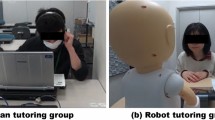Abstract
This work describes a new methodology for correcting voice defects contained in the Arabic speeches and assisting learners of Arabic vocabulary. For this purpose, we follow four stages. The first step consists in localizing the vocal disabilities which degrade an Arabic voice signal, so we focus on comparing between a referenced probabilistic-phonetic model and a speaker model. Second, we differentiate two cases: Degraded speeches can be generated from pathological problems, or it can be produced by non arabophone learners. Hence, we compare between forced alignment scores. Third, we develop a new algorithm to correct pathological pronunciations. The last task is the conception of an application assisting learners of Arabic vocabulary in improving their pronunciation. The achieved results are encouraging. Moreover, learners of Arabic vocabulary have presented a good amelioration using the developed application. A lot of applications that design systems of voice signal processing can use our proposition.







Similar content being viewed by others
References
Ajibola AS, Rashid NKBAM, Sediono W, Hashim NNWN (2016) A novel approach to stuttered speech correction. Komputer dan Informasi, Jurnal Ilmu
Alghamdi M, Almuhtasib H, Elshafei M (2004) Arabic phonological rules. King Saud University Journal: Computer Sciences and Information 16
Aljawarneh S (2011) A web engineering security methodology for e-learning systems. Netw Secur 2011(3):12–15
Ayadi R, Maraoui M, Zrigui M (2016) A survey of Arabic text representation and classification methods, research in computing. Science 117
Bassil Y, Alwani M (2012) Post-Editing Error Correction Algorithm for Speech Recognition using Bing Spelling Suggestion, International Journal of advanced Computer Science and Applications, Vol. 3, N° 2
Belgacem M (2011) Reconnaissance automatique de la parole et ALAO: Vers un système d’apprentissage de l’arabe oral, PhD thesis. Stendhal university, Grenoble, France
Biadsy F, Hirschberg J, Habash N (2009) Spoken Arabic dialect identification using phonotactic modeling, In Proceedings of the eacl 2009 workshop on computational approaches to semitic languages
Blanc-Brude T (2004) Intégration de commandes vocales dans un environnement d'apprentissage par l'action: enjeux ergonomiques, Doctoral dissertation, Grenoble 1
Bréhilin L, Gascuel O (2000) Modèles de Markov caches et apprentissage de séquences
Elshafei M, Almuhtasib H, Alghamdi M (2002) Techniques for high quality text-to-speech. Information Science
Elshafei M, Almuhtasib H, Alghamdi M (2006) Statistical methods for automatic Diacritization of Arabic text, In Proceedings of 18th national computer conference, Riyadh, Saudi Arabia
Haffar N, Maraoui M., Aljawarneh S (2016) Use of indexed Arabic text in e-learning system, international conference on engineering & MIS (ICEMIS), Agadir, Morocco
Hawashin B, Mansour A, Aljawarneh S, Fahmy AA, Al Raddady F, Shrivastava A, Rajawat AS, Malika CR, Mishra S, Yadav RN (2013) An efficient feature selection method for Arabic text classification, Int. J. Comput. Appl., Vol. 83, N° 17
Kaki S, Sumita E, Iida H (1998) A method for correcting errors in speech recognition using the statistical features of character co-occurrence, In COLING-ACL, Montreal
Majidnezhad V, Kheidorov I (2012) A HMM-based method for vocal fold pathology diagnosis. IJCSI International Journal of Computer Science Issues, Vol. 9, Issue 6, N° 2
Majidnezhad V, Kheidorov I (2013) An ANN-based method for detecting vocal fold pathology, International Journal of Computer Applications, Volume 62, N° 7
Maraoui M, Zrigui M, Antoniadis G (2012) Use of NLP Tools in CALL System for Arabic, Int. J. Comput. Proc. Oriental Lang. Vol. 24, N° 2
Meddeb O, Maraoui M, Aljawarneh S (2016) Hybrid modeling of an OffLine Arabic handwriting recognition system AHRS, international conference on engineering & MIS (ICEMIS), Agadir, Morocco
Online: http://www.un.org/french/disabilities/default.asp?navid=35&pid=833 [consulted April 6th, 2016]
Online: http://kenanaonline.com/users/dkkhaledelnagar/photos/1238136361 [consulted April 24th, 2016]
Paquet P (1997) L’utilisation des réseaux de neurones artificiels en finance. Document de recherche N° 1997–1
Patane G, Russo M (2001) The enhanced LBG Algorithm, Neural networks, Vol. 14, N° 9
Terbeh N, Zrigui M (2014) Vers la Correction Automatique de la Parole Arabe, Citala 2014, Oujda, Morocco
Terbeh N, Zrigui M (2016) A novel approach to identify factor posing pronunciation disorders. In international conference on computational collective intelligence (ICCCI2016), Halkidiki, Greece
Terbeh N, Labidi M, Zrigui M (2013) Automatic speech correction: a step to speech recognition for people with disabilities, ICTA 2013, Hammamet, Tunisia
Terbeh N, Maraoui M, Zrigui M (2015) Probabilistic approach for detection of vocal pathologies in the Arabic speech, CICLing 2015. Cairo, Egypt
Terbeh N, Trigui A, Maraoui M, Zrigui M (2016) Arabic speech analysis to identify factors posing pronunciation disorders and to assist learners with vocal disabilities, international conference on engineering & MIS (ICEMIS), Agadir, Morocco
Vu HH, Villaneau J, Saïd F, Marteau PF (2015) Mesurer la similarité entre phrases grâce à Wikipédia en utilisant une indexation aléatoire, 22nd Traitement Automatique des Langues Naturelles, Caen
Wali W, Gargouri B, Ben Hamadou A (2017) Enhancing the sentence similarity measure by semantic and syntactico-semantic knowledge, Vietnam J. Computer. Science 4(1):51–60
Zhou Z, Meng HM, Lo WK (2006) A multi-pass error detection and correction framework for mandarin LVCSR, in proceedings of the international conference on spoken language Processing, Pittsburgh
Setlur AR, Sukkar RA, Jacob J (1996) Correcting recognition errors via discriminative utterance verification, In Proceedings of the international conference on spoken language processing. Philadelphia
Acknowledgements
The editors and reviewers within the MTAP journal are acknowledged about their critics, remarks and comments to ameliorate the quality of this paper. My supervisors Mr. Mohsen Maraoui and Mr. Mounir Zrigui are also thanked for their valuable support to achieve this work.
Author information
Authors and Affiliations
Corresponding author
Rights and permissions
About this article
Cite this article
Terbeh, N., Trigui, A., Maraoui, M. et al. Correction of pathological speeches and assistance to learners with vocal disabilities. Multimed Tools Appl 77, 17779–17802 (2018). https://doi.org/10.1007/s11042-017-5447-6
Received:
Revised:
Accepted:
Published:
Issue Date:
DOI: https://doi.org/10.1007/s11042-017-5447-6




